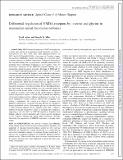Files in this item
Differential regulation of NMDA receptors by D-serine and glycine in mammalian spinal locomotor networks
Item metadata
| dc.contributor.author | Acton, David | |
| dc.contributor.author | Miles, Gareth B. | |
| dc.date.accessioned | 2017-05-22T12:30:11Z | |
| dc.date.available | 2017-05-22T12:30:11Z | |
| dc.date.issued | 2017-05-01 | |
| dc.identifier | 249142960 | |
| dc.identifier | dc849b75-204b-4fc7-a683-f0609007718f | |
| dc.identifier | 85018363359 | |
| dc.identifier | 000401902400006 | |
| dc.identifier.citation | Acton , D & Miles , G B 2017 , ' Differential regulation of NMDA receptors by D-serine and glycine in mammalian spinal locomotor networks ' , Journal of Neurophysiology , vol. 117 , no. 5 , pp. 1877-1893 . https://doi.org/10.1152/jn.00810.2016 | en |
| dc.identifier.issn | 0022-3077 | |
| dc.identifier.other | ORCID: /0000-0002-8624-4625/work/30506268 | |
| dc.identifier.uri | https://hdl.handle.net/10023/10809 | |
| dc.description | This work was supported by an Institutional Strategic Support Fund grant from the Wellcome Trust. | en |
| dc.description.abstract | Activation of N-methyl-d-aspartate receptors (NMDARs) requires the binding of a coagonist, either d-serine or glycine, in addition to glutamate. Changes in occupancy of the coagonist binding site are proposed to modulate neural networks including those controlling swimming in frog tadpoles. Here, we characterize regulation of the NMDAR coagonist binding site in mammalian spinal locomotor networks. Blockade of NMDARs by d(−)-2-amino-5-phosphonopentanoic acid (d-APV) or 5,7-dichlorokynurenic acid reduced the frequency and amplitude of pharmacologically induced locomotor-related activity recorded from the ventral roots of spinal-cord preparations from neonatal mice. Furthermore, d-APV abolished synchronous activity induced by blockade of inhibitory transmission. These results demonstrate an important role for NMDARs in murine locomotor networks. Bath-applied d-serine enhanced the frequency of locomotor-related but not disinhibited bursting, indicating that coagonist binding sites are saturated during the latter but not the former mode of activity. Depletion of endogenous d-serine by d-amino acid oxidase or the serine-racemase inhibitor erythro-β-hydroxy-l-aspartic acid (HOAsp) increased the frequency of locomotor-related activity, whereas application of l-serine to enhance endogenous d-serine synthesis reduced burst frequency, suggesting a requirement for d-serine at a subset of synapses onto inhibitory interneurons. Consistent with this, HOAsp was ineffective during disinhibited activity. Bath-applied glycine (1–100 µM) failed to alter locomotor-related activity, whereas ALX 5407, a selective inhibitor of glycine transporter-1 (GlyT1), enhanced burst frequency, supporting a role for GlyT1 in NMDAR regulation. Together these findings indicate activity-dependent and synapse-specific regulation of the coagonist binding site within spinal locomotor networks, illustrating the importance of NMDAR regulation in shaping motor output. | |
| dc.format.extent | 23906863 | |
| dc.language.iso | eng | |
| dc.relation.ispartof | Journal of Neurophysiology | en |
| dc.subject | Motor control | en |
| dc.subject | Central pattern generator | en |
| dc.subject | Spinal cord | en |
| dc.subject | Neuromodulation | en |
| dc.subject | RC0321 Neuroscience. Biological psychiatry. Neuropsychiatry | en |
| dc.subject | NDAS | en |
| dc.subject.lcc | RC0321 | en |
| dc.title | Differential regulation of NMDA receptors by D-serine and glycine in mammalian spinal locomotor networks | en |
| dc.type | Journal article | en |
| dc.contributor.sponsor | The Wellcome Trust | en |
| dc.contributor.institution | University of St Andrews. School of Psychology and Neuroscience | en |
| dc.contributor.institution | University of St Andrews. Institute of Behavioural and Neural Sciences | en |
| dc.identifier.doi | 10.1152/jn.00810.2016 | |
| dc.description.status | Peer reviewed | en |
| dc.identifier.url | http://jn.physiology.org/content/117/5/1877.figures-only | en |
| dc.identifier.grantnumber | 105621/Z/14/Z | en |
This item appears in the following Collection(s)
Items in the St Andrews Research Repository are protected by copyright, with all rights reserved, unless otherwise indicated.

